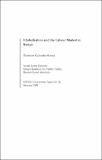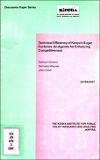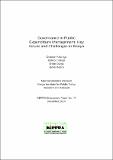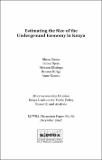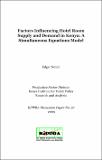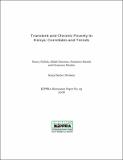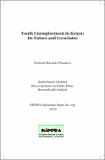Search
Now showing items 21-30 of 71
Discussion Paper No. 32 of 2004 on User Charges and Utilization of Health Services in Kenya
(The Kenya Institute for Public Policy Research and Analysis, 2004)
This paper uses data from Kenya to examine the role of user charges and quality
of health services in determining the choice of healthcare providers. We find
that an increase in the price of public health services diverts ...
Occasional Paper No. 03 of 2002 on Agriculture, Economic Growth and Poverty Reduction
(The Kenya Institute for Public Policy Research and Analysis (KIPPRA), 2002)
Reducing poverty is a primary focus of public policy in most developing countries, a fact that is underscored by the recent emphasis on the formulation of Poverty Reduction Strategy Papers (PRSPs) by African governments, ...
Discussion Paper No. 31 of 2004 on Globalisation and the Labour Market in Kenya
(The Kenya Institute for Public Policy Research and Analysis (KIPPRA), 2004)
This paper analyses the effect of globalisation on the labour market outcomes
in Kenya using micro datasets complemented with secondary data. The analysis
shows that during the economic reform period (1970s to 1990s), ...
Discussion Paper No. 55 of 2006 on Financing of Secondary Education in Kenya: Costs and Options
(The Kenya Institute for Public Policy Research and Analysis, 2006)
This study examines the financing of secondary education in Kenya and explores possible financing options for the next ten years. This study uses data from various sources, including education trend statistics, the 2003 ...
Discussion Paper No. 84 of 2007 on Technical Efficiency of Kenya's Sugar Factories: An Agenda for Enhancing Competitiveness
(The Kenya Institute for Public Policy Research and Analysis, 2007)
This paper provides estimates of technical efficiency in Kenya sugar
factories. It examines factors that affect technical efficiency by applying
a stochastic production frontier approach over the period 1996-2005
using ...
Discussion Paper No. 77 of 2007 on Governance in Public Expenditure Management: Key Issues and Challenges in Kenya
(The Kenya Institute for Public Policy Research and Analysis (KIPPRA), 2007)
This paper develops a conceptual framework for applying good governance to systems of public expenditure management (PEM), and analyses governance in public expenditure management in Kenya. An overview of some key governance ...
Discussion Paper No. 82 of 2007 on Estimating the Size of the Underground Economy in Kenya
(The Kenya Institute for Public Policy Research and Analysis (KIPPRA), 2007)
The underground economy comprises economic activities not accounted for in national income statistics and is, therefore, difficult to measure. The difficulty arises because this economy comprises a host of traditional and ...
Discussion Paper No. 97 of 2009 on Factors Influencing Hotel Room Supply and Demand in Kenya: a Simultaneous Equations Model
(The Kenya Institute for Public Policy Research and Analysis (KIPPRA), 2009)
Accommodation is a key component of the tourism industry in Kenya, which has been recognized as a key sector in the economic pillar of the country’s Vision 2030. Therefore, the envisaged growth of the tourism industry in ...
Discussion Paper No. 95 of 2008 on Transient and Chronic Poverty in Kenya: Correlates and Trends
(The Kenya Institute for Public Policy Research and Analysis (KIPPRA), 2008)
The pattern of poverty incidence in Kenya has changed over time, with some households moving in and out of poverty while others or their descendants have remained in poverty for decades. Rural poverty, for instance, increased ...
Discussion Paper No. 103 of 2009 on Youth Unemployment in Kenya: Its Nature and Covariates
(The Kenya Institute for Public Policy Research and Analysis (KIPPRA), 2009)
Unemployment among the youth is one of the major policy concerns of
the Government of Kenya, because it imposes costs on individual youth,
their families and the economy. Aware of this policy concern, this study
uses a ...



